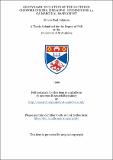Geodynamic evolution of the southern chewore inliers, Zimbabwe: evidence for 1.4 Ga marginal basin crust
Abstract
This thesis reports the detailed study of 150 km2 of a newly discovered ophiolite terrane in the Chewore Inliers of northern Zimbabwe. It is apparently the oldest dated ophiolite (senso stricto) in Africa. Field and laboratory investigation of the Ophiolite Terrane (OT) shows that it comprises three distinct lithological groups. The Maunde Ophiolite Group is comprised of back - arc ophiolite - type assemblages, namely:-meta - mafic volcanics, sheeted meta - mafic dykes, meta - gabbro, meta - mafic cumulates and serpentinites. The Kaourera Island - Arc Group is comprised of a silica and potassium variable suite of extrusive volcanic lithologies which represent a tectonically excised island - arc complex. The Kadunguri Whiteschists are comprised of chemically restricted whiteschists which are characterised by the equilibrium assemblage of talc and kyanite and unusual yoderite + kyanite + chlorite + talc + dravite + hematite assemblages. The Ophiolite Terrane has had a single period of crustal thickening with a NNE - SSW shortening direction. This event is characterised by high shear strains with the development of non - coaxial intrafolial shear folds, an axial planar cleavage and an extension lineation which is parallel to the intrafolial fold hinges. Tectonic transport was directed obliquely toward the NNE. Associated clockwise metamorphism peaked within the upper amphibolite facies at 700°C and 10 kbar. The high pressure, moderate temperature Kadunguri Group whiteschists record peak metamorphic PT's of between 13 and 21 kbar and 550 - 650°C with the production of the second natural occurrence of the mineral yoderite. A plagiogranite sheet within the ophiolite has been SHRIMP dated at 1393 ± 22 Ma (Oliver et al., 1998) and is interpreted to be the age of the ophiolite. Investigation of the terranes to the north of the OT by Goscombe et al., (1998) reveal a previous, high T, low P, anti - clockwise, local granulite facies tectono - metamorphic cycle (M1) which is not recognised within the OT. All terranes are variably overprinted by the main clockwise PTt path, amphibolite facies, crustal thickening event (M2). The M1 cycle has been U / Pb SHRIMP dated from zircons within the Granulite Terrane at 943 ± 34 Ma (Goscombe et al., 1998) and interpreted to represent crustal extension associated with continental break up of Rodinia. Zircon overgrowths within the Granulite Terrane date the M2 cycle at 524 ± 16 Ma. The lack of M1 metamorphism and associated fabrics within the OT and the similarity in early M2 structures between all terranes indicate that juxtaposition of the Chewore terranes occurred during the earliest part of the M2 cycle i.e., at 524 ± 16 Ma. The plethora of Pan - African radiometric ages (c. 520 - 530 Ma) throughout the Zambezi Belt suggests that the belt containing the OT represents a complex east to west trending suture zone which divides West Gondwana into a 'northern' (Congo Craton) and 'southern' (Zimbabwe Craton) component. The Zimbabwe and Congo Cratons were therefore ultimately juxtaposed during the Pan - African Orogeny.
Type
Thesis, PhD Doctor of Philosophy
Collections
Items in the St Andrews Research Repository are protected by copyright, with all rights reserved, unless otherwise indicated.

